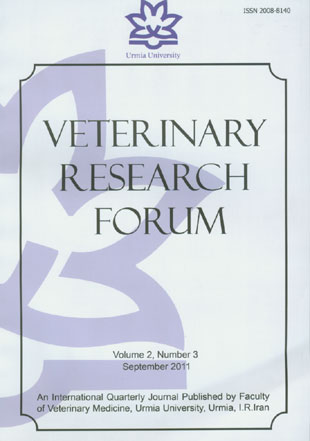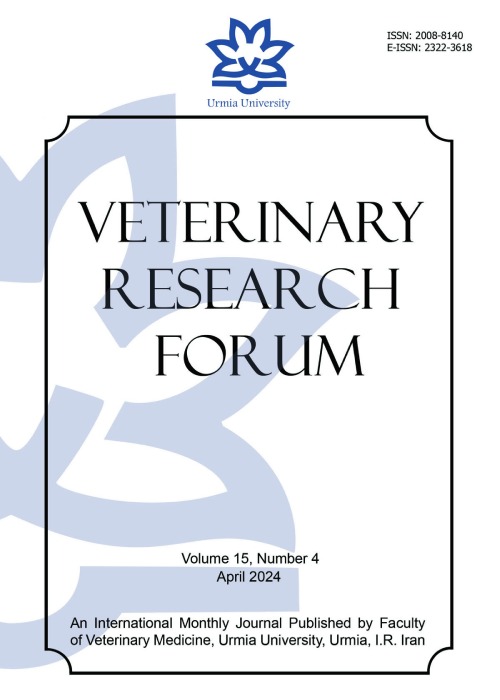فهرست مطالب

Veterinary Research Forum
Volume:2 Issue: 3, Summer 2011
- 76 صفحه،
- تاریخ انتشار: 1390/07/20
- تعداد عناوین: 11
-
-
Page 139
-
Page 141
-
Page 147Nutrigenomics applies genomic technologies to study how nutrients affect expression of genes. With the advent of the post genomic era and with the use of functional genomic tools, the new strategies for evaluating the effects of nutrition on production efficiency and nutrient utilization are becoming available. Nutrigenomics plays an efficient role in various fields of animal health like nutrition, production, reproduction, disease process etc. Nutrigenomic approaches will enhance researchers‟ abilities to maintain animal health, optimize animal performance and improve milk and meat quality.
-
Page 157Salmonella enterica serovar Typhimurium and S.enterica serovar Enteritidis are the mostfrequently isolated serovars from food-borne diseases throughout the world. According to their antigenic profiles, salmonella shows different disease syndromes and host specificities. It is necessary and important to discriminate salmonella serovars from each other in order to ensure that each pathogen and its epidemiology are correctly recognized. Many PCR-based methods have been developed to identify salmonella serovars. The objective of present study was to identify S. Typhimurium in avians from different regions including: North, Northwest and capital city (Tehran) of Iran. Also in this research, the quality of CHROMagar™ Salmonella medium (CAS medium) in veterinary medicine was evaluated. The results of present study showed that out of 1870 intestine samples, fifty two S. Typhimurium including broiler (n=13), layer (n=12), duck (n=5), goose (n=5), sparrow (n=8), canary (n=3), pigeon (n=5) and African grey parrot (n=1) were identified using serotyping as well as multiplex-PCR. In conclusion, important measures must be taken on prevention and propagation of S. Typhimurium among avians. CHROMagar™ Salmonella medium has high levels of sensitivity and specificity and reduced the time to final identification of salmonella spp. in comparison with biochemical tests.
-
Page 167The objectives of the present study were to investigate the prevalence of histologic thyroids lesions and the respective thyroid hormones changes of ewes in an endemic goiter region and to find out any impact of this condition on the fetal thyroid structures and serum thyroid hormones. In the present study a total number of 100 pregnant ewes and their fetuses slaughtered at slaughterhouse were selected for the study. The sera were prepared from the jugular vein blood of ewes and fetuses umbilical cords. The ewes and fetuses thyroids subjected to histopathological examination and radioimmunoassay procedure was used for sera T3 and T4 assay. The results showed a high prevalence of thyroid lesions in ewes and their fetuses. The different kinds of lesions including cysts, follicular hyperplasia, hemorrhage and inflammation were seen in ewes. In the fetuses thyroid structural changes were cysts resemble structures; hemorrhage and hyperemia. Mean T4 concentration was significantly higher in the ewes with pathologic thyroid compared to normal animals. However, there was not any significant difference between pathologic and normal ewes’ thyroids on serum T3. Although, existence of lesions on fetal thyroids did not affect the serum concentrations of T4 and T3, there was a significant correlation between T4 and T3 serum concentrations of fetuses and their age. In conclusion, the significant prevalence of fetal and maternal thyroid pathological changes in the endemic goiter region raises a question about probable congenital source of these variations. The thyroid lesions significantly influenced the functions of mothers'' gland but not fetuses.
-
Page 177The autonomic nervous system consists of a vast range of nerves and ganglions. Anatomical studies have demonstrated that the sympathetic innervations of the head and neck are affected by the neurons that ramify from the cranial cervical ganglion (CCG). The CCG is the end of the sympathetic cervical trunk, which runs with the vagal nerve during its cervical course. In this study sixteen adult (2 - 5 year) river buffalo of both sexes (eight male, eight female) weighing around 250 - 450 kg were dissected to investigate the weight, situation and arrangement of nerve branches of the cranial cervical ganglion bilaterally. The ganglions showed a fusiform shape and reddish in color. The cranial cervical ganglion covered by the digastricus muscle. It lies in dorsal region of the base of epiglottic cartilage, ventromedial to tympanic bulla and ventrally to atlantic fossa, and medial of the occipital artery. This study showed that the cranial cervical ganglions in river buffalo were well-developed structure. The main branches of cranial cervical ganglion included the internal carotid, external carotid and jugular nerves.
-
Page 183Shiga toxin-producing Escherichia coli (STEC) are food-borne pathogens primarily associated with the consumption of contaminated ground beef and are an important food safety concern worldwide. STEC has been found to produce a family of related cytotoxins known as Shiga toxins (Stxs). Shiga toxins have been classified into two major classes, Stx1 and Stx2. A single strains of STEC can produce Stx1, Stx2 (or its variants) or both. The aims of this project were to determine the prevalence and molecular characteristics of STEC isolates from chicken flocks in Northwest of Iran. A total of 350 fecal samples from 28 broiler farms were screened for the presence of STEC by conventional culture methods and polymerase chain reaction (PCR). All samples were initially subjected to phenotypical analysis using the Sorbitol MacConkey agar plate for the detection of the sorbitol negative E. coli, and then for genotypic analysis, by multiplex PCR for detection of stx1and stx2 genes. STEC were isolated from 14 (4 %) chicken fecal samples. To our knowledge, this is the first report of isolation of STEC from poultry in Iran. To conclude, this work revealed the presence STEC strains harboring stx1 and stx2 gene in healthy chicken fecal samples in Northwest of Iran suggesting they can play as an important potential source of contamination for people working on broiler farms or are in contact with chicken carcasses at meat processing plants.
-
Page 189This study was designed to clarify bilaterally effect of long-time varicocele on left and right testes and to identify the effect of varicocele on maturation divisions during spermatogenesis. Moreover, the percentage of seminiferous tubules (STs) with I-VIII and IX-XIV stages of spermatogenesis and sperm parameters such as sperm motility and abnormality types were evaluated. The left varicocele was induced in test group (n=18) and control-sham animals (n=6) were gone under simple laparatomy. The test group further sub-divided into three subgroups based on the duration of varicocele (4, 6 and 8 months after varicocele induction). The histological alterations, spermiogenesis index (SPI), Sertoli cells (SCs), cytoplasmic lipid and alkaline phosphatase (ALP), germinal cells first and second maturation divisions, spermatogenesis stages, natural mating and sperm characteristics (count, motility and abnormality) were evaluated. Histological results showed that the varicocele-induced damage affected both stages of I-VIII and IX-XIV and up to 20% of the STs exhibited negative SPI and SCs degeneration. After 8 months, majority of STs demonstrated a remarkable reduction in the first and second maturation division in both of the testes. Nevertheless, the right testicles were manifested with significantly (P < 0.05) lower detrimental features in comparison with the left ones. Following varicocele induction the sperm count, viability and motility reduced time-dependently. Our data suggested that monolateral varicocele-induction affected both right and left testicles simultaneously albeit with differences. The varicocele-induced injuries were manifested as negative SPI and SCs degeneration, which may have led to poor sperm quantity and quality.
-
Page 203For induction of ruminal acidosis, 10 clinically healthy three years old non pregnant female sheep were selected. Prior to the infusion of sucrose (0 hour), rumen and blood samples were obtained in order to determine baseline rumen and blood pH, respectively. Electrocardiogram (ECG) was also recorded. Acute ruminal acidosis was induced experimentally with sucrose at a dose of 18g kg-1 body weigh through rumen fistula. ECG was recorded and blood and rumen samples collected at 3, 6, 9, 12, 15, 18, 21, 24, 30, 36, and 48 hours after the infusion of sucrose. Results indicated that blood and rumen pH decreased significantly at 15, 18, 21, 24, 30, 36 and 48 hours and at 3, 6, 9, 12, 15, 18, 21, 24, 30, 36 and 48 hours, respectively. Acidosis produced a marked increasing in heart rate and a decrease in PR interval at 15 and 18 hour significantly with little apparent effect on the ST and PR segment. The P amplitude increased significantly at 6, 9, 12, 15, 18, 21, 24 and 30 hours. The T amplitude increased significantly at 9, 12, 15, 18, 21, 24, 30 and 36 hours. The RR interval decreased significantly at 6, 9, 12, 15, 18, 21, 24, 30, 36 and 48 hours. In conclusion acute ruminal acidosis caused significant changes in ECG of sheep though there was not any detectable arrhythmia in the ECG in acute ruminal acidosis.
-
Page 209Systemic amyloidosis and testicular interstitial tumor are rare conditions in birds and this is the first report in Iran. A male zebra finch was presented because of white diarrhea, anorexia, loss of weight and lethargy. At necropsy, the small intestine was edematous and congested. The spleen appeared pale. The liver was large, firm and brown. One testis was cystic and neoplastic and the remaining testis was atrophic. Histologically, amyloid materials were seen predominantly in the liver and spleen. Hyaline substances were deposited in the Disse space and in the media of blood vessels of the liver. In spleen, marked deposits thickened the basement membranes of blood vessels and extended into the surrounding parenchyma. In addition, there were lesser degrees of amyloidosis in other organs such as small intestine. Amyloid stained positively with Congo red. In testis, there was encapsulated unilateral interstitial cell tumor, with multiple foci of necrosis and hemorrhage. The neoplastic cells were round to polyhedral, with small round hyperchromatic nuclei and finely vacuolated cytoplasm. Signs of feminization were observed. The cause of amyloidosis in this study was not conclusively identified.


